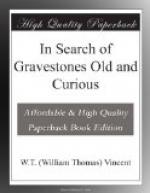The stone represented below, 101 b, bears an inscription in Runic characters. Runic is a term applied to any mysterious writing; but there were three leading classes of “runes”—Scandinavian, German, and Anglo-Saxon—all agreeing in certain features, and all ascribed by some authorities to the Phoenicians. The stone 101 b was found in 1865, at Kilbar, Barra, a remote island of the outer Hebrides, off the north-west coast of Scotland. It measures 6 ft. 5-1/2 in. in height, and its greatest width is 15-1/2 inches. Mr. Carmichael has conjectured that it was probably brought from Iona about the beginning of the seventeenth century, and erected in Barra at the head of a grave made by a son of McNeil for himself. But it is believed to have been in any case a Norse memorial in the first instance, though certainly Christian, for it reads:
“Ur and Thur Gared set up the stones of Riskar.[18] May Christ guard his soul.”
[Footnote 18: Riskar, or Raskar, is a surname of the Norwegians, who were early settled in the Western Islands and adopted the Christian faith.—“Old Northern Runic Monuments of Scandinavia and England,” by Dr. George Stephens, F.S.A.]
The Barra stone has on the reverse side a large cross, carved in plaited bands. Dr. Petrie has pointed out that the cross is not necessarily indicative of belief, the ancient Danes and other peoples having used various signs—the cross frequently—to mark their boundaries, their cattle, and their graves.[19] There is little doubt, however, that in most of these British and Irish memorials, although the stones may originally have been Pagan, the cross is typical of Christianity. We are told that it was not unusual for St. Patrick to dedicate Pagan monuments to the honour of the true God. On one occasion, it is related, on the authority of an ancient life of the Saint, that, on coming to the Plain of Magh Solga, near Elphin, he found three pillar stones which had been raised there by the Pagans, either as memorials of events or for the celebration of Pagan rites, on one of which he inscribed the name of Jesus, on another Soter, and on the third Salvator, along probably with the cross, such as is seen on nearly every Christian monument in Ireland. In the same way on two of five upright pillars in the parish of Maroun, Isle of Man, are crosses deeply incised. This spot is traditionally associated with St. Patrick as the place where he preached, and the stones appear to be remains of a Druidical circle.
[Footnote 19: “Christian Inscriptions in the Irish Language.” Collected by George Petrie, and edited by Miss M. Stokes.]
This practice is quite consistent with the principles upon which the Christian conversion was established by the early missionaries. Thus, Gregory, in a letter from Rome, in 601, directed that the idolatrous temples in England should not be destroyed, but turned into Christian churches, in order that the people might be induced to resort to their customary places of worship; and they were even allowed to kill cattle as sacrifices to God, as had been their practice in their previous idolatry. Hence also arose the system of establishing new churches on the sites previously held as consecrated by heathen worship.




